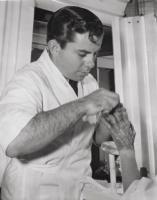
Bud Westmore, of the Westmore dynasty of Hollywood make-up artists, was Head of Make-up at Universal and is credited on more than 450 movies and TV shows. His credits include the Lon Chaney biopic starring James Cagney, Man of a Thousand Faces[1957] and The Andromeda Strain[1971].
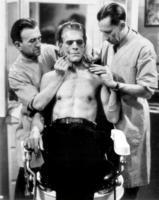
Jack Pierce(on left), assisted by Otto Lederer, applies make-up to Boris Karloff at Universal Studios in 1931. Pierce’s brilliant design for the Monster (in collaboration with director James Whale) was a perfect match with Karloff’s gaunt features, making his Frankenstein Monster an international icon. Pierce also created the make-ups for other classic Universal Monsters including The Mummy[1932], Werewolf of London[1935], and The Wolf Man[1941].
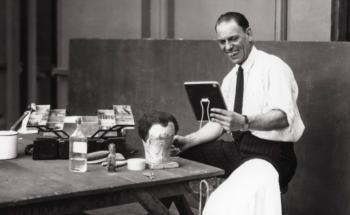
Lon Chaney, pictured with his make-up kit, checks out a set of false teeth in his mirror on the set of A Blind Bargain[Wallace Worsley, 1922]. Chaney was known as “The Man of a Thousand Faces” for his remarkable ability to turn himself into dozens of grotesque characters. Erik, The Phantom of the Opera[Rupert Julian, 1925] and Quasimodo, The Hunchback of Notre Dame[Wallace Worsley, 1923] are his two most famous roles.
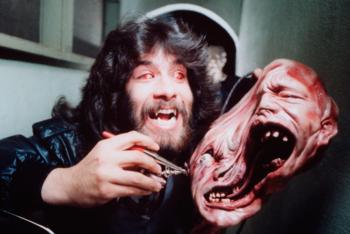
Rob Bottin(wearing scary contact lenses) poses with one of his creations for John Carpenter’s The Thing[1982], a movie that really showcases his amazing work. Rob made the grotesque murder victim tableaus in David Fincher’s Seven[1995], the werewolves in Joe Dante’s The Howling[1981], and the mythical creatures in Ridley Scott’s Legend[1985] including Tim Curry’s remarkable Lord of Darkness.
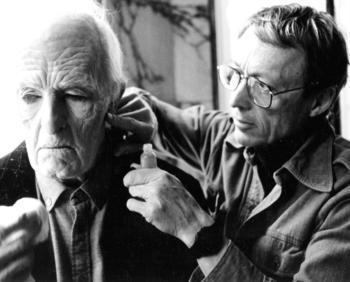
Dick Smith, pictured turning David Bowie into an ancient vampire in Tony Scott’s The Hunger[1983], is called the godfather of special effects make-up. Dick’s legendary make-ups include: The Exorcist[William Friedkin, 1973], The Godfather[Francis Ford Coppola, 1972], Taxi Driver[Martin Scorsese, 1976]; he received an Academy Award for Amadeus[Milos Forman, 1984].
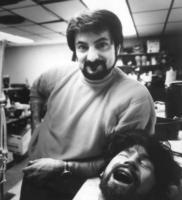
Tom Saviniis noted for his gory make-ups in Maniac[William Lustig, 1980] and Friday the 13th[Sean S. Cunningham, 1980], and his many collaborations with George A. Romero. Now active as an actor, he played Sex Machine in From Dusk Till Dawn[Robert Rodriguez, 1996]. Tom also runs a successful make-up academy.
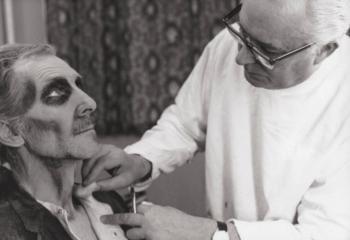
Roy Ashtonwas Hammer Studios’ main make-up artist, shown here making-up Peter Cushing as the living dead Arthur Grimsdyke for Tales from the Crypt[Freddie Francis, 1972].
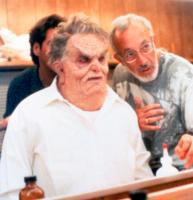
Stan Winston, pictured with Michael Jackson in make-up for the short film Ghosts[Stan Winston, 1997]. Stan won three Academy Awards; one for Make-up and one for Special Effects for Terminator 2: Judgment Day[James Cameron, 1991], and one for Special Effects for his lifelike, full-size animatronic dinosaurs in Jurassic Park[Steven Spielberg, 1993].
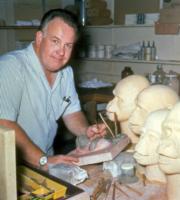
John Chamberswon an honorary Academy Award for his groundbreaking work on Planet of the Apes[Franklin J. Schaffner, 1968]. John’s foam-rubber, prosthetic appliances allowed facial mobility and could be mass-produced to equip large numbers of actors. Chambers also did clandestine disguise work for the FBI and CIA and played the National Guard Captain in Schlock[1971].
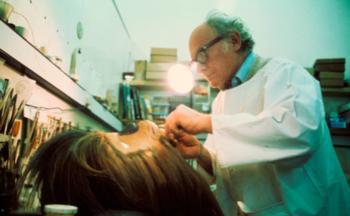
Stuart Freebornmade the apes for Stanley Kubrick’s 2001: A Space Odyssey[1968]. He is shown here working on Chewbacca’s head for George Lucas’ Star Wars[1977].
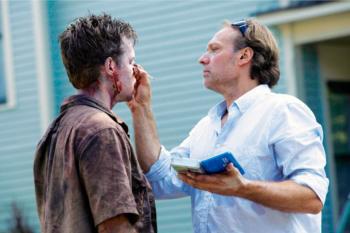
Gregory Nicoterois the N in famed special effects make-up company KNB. Greg often collaborates with Quentin Tarentino, Robert Rodriguez, Frank Darabont, and George A. Romero. Here’s Greg working on the hit TV zombie series The Walking Dead[2010-].
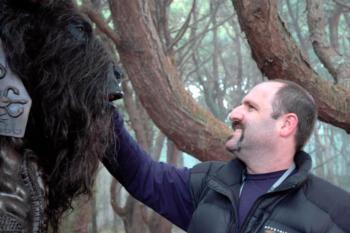
Howard Bergeris the B in KNB. Howard won an Academy Award for his work on The Chronicles of Narnia: The Lion, the Witch and the Wardrobe[Andrew Adamson, 2005].
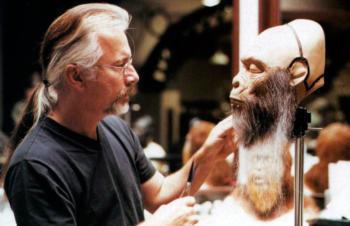
Rick Bakerworking on an appliance for Tim Burton’s remake of Planet of the Apes[2001]. Rick and I first met on my first feature film Schlock[1971]. He was 20, I was 21. Since then, Rick has gone on to win seven Academy Awards, his first for An American Werewolf in London[1981], when the Academy established the category.
MONSTER DESIGNERS
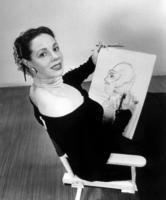
Millicent Patrickdesigning the Gill-Man for Creature From the Black Lagoon[Jack Arnold,1954]. Ms. Patrick was not given a screen credit for what many consider one of the greatest monster designs.
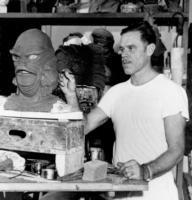
Chris Muellerin the Universal Make-up lab, sculpting the original mask for Creature From the Black Lagoon.
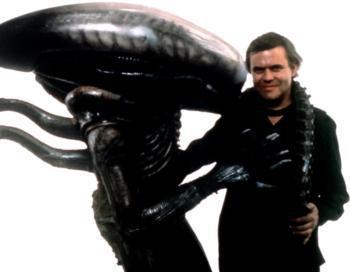
H. R. Gigeris a Swiss artist known for his surreal and bizarre paintings. Ridley Scott hired him to design the title creature in Alien[1979]. Giger is pictured here with one of his friends.
STOP-MOTION ANIMATION
Stop-motion animation is an art that is still practiced by filmmakers like Henry Selick in The Nightmare Before Christmas[1993], James and the Giant Peach[1996], and Coraline[2009] and Nick Park. Park is the creator of Wallace and Gromit and has won four Academy Awards, for Creature Comforts[1989], The Wrong Trousers[1993], A Close Shave[1995], and Wallace & Gromit: The Curse of the Were-Rabbit[2005]. Pictured are three of the greatest stop-motion animators in movie history.
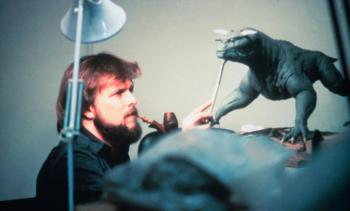
Randall Cookis shown animating a demon from Ghostbusters[Ivan Reitman, 1984].
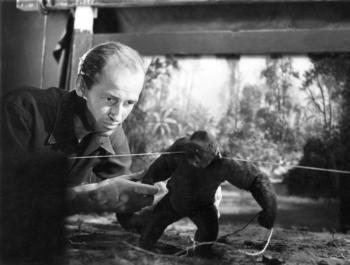
Ray Harryhausenanimating Mighty Joe Young[Ernest B. Schoedsack, 1949]. Ray’s big break came when Willis O’Brien hired him as an assistant on this movie. Ray Harryhausen’s tremendous body of work has had enormous influence on generations of filmmakers.
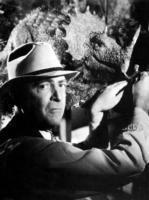
Willis O’Brien, the pioneering stop-motion animator and innovator, whose crowning achievement is King Kong[Merian C. Cooper, Ernest B. Schoedsack, 1933]. O’Brien is pictured here with the triceratops the ship’s crew discover on Skull Island. In his hand he holds a crew member puppet. O’Brien’s film work goes back to 1915 with The Dinosaur and the Missing Link: A Prehistoric Tragedyfor the Edison Co. His last film was Stanley Kramer’s It’s a Mad, Mad, Mad, Mad World[1963].